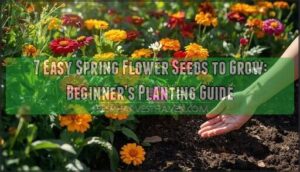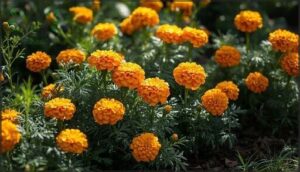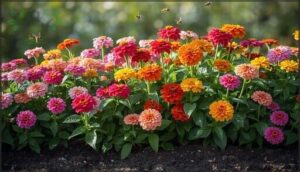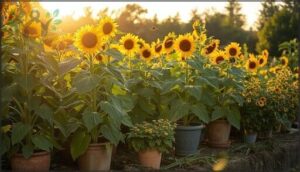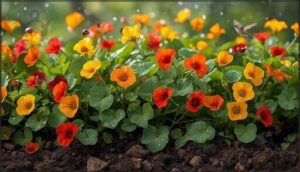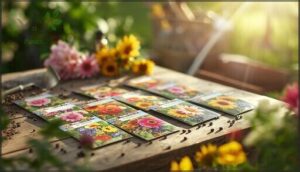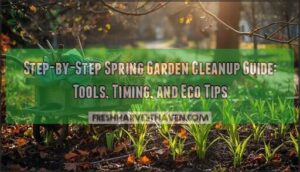This site is supported by our readers. We may earn a commission, at no cost to you, if you purchase through links.
One handful of easy spring flower seeds can tilt the garden in your favor—no green thumb required. Sun-bleached zinnias burst through tired soil, marigolds outmaneuver pests while cosmos defy the odds with sprouts days after planting.
Seasoned gardeners know: control is overrated when nature wants to surprise you. Mixing annual and perennial seeds doesn’t just boost color—it turns empty beds into a living patchwork, inviting pollinators and turning chores into something closer to freedom.
With a few practical tips, you’ll find these blooms do most of the heavy lifting, leaving more time for you to enjoy what grows next.
Table Of Contents
- Key Takeaways
- Top Easy Spring Flower Seeds to Grow
- Choosing The Right Flower Seeds
- Seed Starting and Planting Tips
- Caring for Easy Spring Flowers
- Maximizing Blooms and Garden Benefits
- Frequently Asked Questions (FAQs)
- What is the easiest flower to grow in spring?
- What is the easiest flower to start from seed?
- What flower seeds to plant in early spring?
- Can I just throw flower seeds on the ground?
- What is the fastest growing flower from seed?
- When should you start flower seeds for spring planting?
- What are the easiest plants to grow from seeds?
- Are flowers easy to grow from seed?
- Which flowers are easy to direct sow?
- How do you grow roses from seed?
- Conclusion
Key Takeaways
- Easy spring flower seeds like marigold, zinnia, cosmos, calendula, and bachelor’s button are foolproof picks, thriving even in unpredictable conditions and poor soil.
- Mixing annuals and perennials, along with succession sowing, keeps your garden blooming and colorful from early spring through summer’s end.
- Preparing loose, well-drained soil, tracking frost dates, and choosing between indoor or direct sowing gives your seeds the best chance to sprout strong.
- Low-maintenance care—steady watering, deadheading, and mulching—lets flowers handle most of the work while attracting pollinators and cutting down on pests.
Top Easy Spring Flower Seeds to Grow
Starting a flower garden from seed doesn’t have to be complicated or expensive. The right flowers can sprout quickly, tolerate beginner mistakes, and bloom all season with minimal fussing.
Starting a flower garden from seed is easy and affordable when you choose forgiving flowers that bloom long and require little effort
Here are seven proven spring flowers that’ll give you confidence and color without the guesswork.
Bachelor’s Button
Bachelor’s Button is a dream for gardening beginners who love growing flowers from seed. These easy-to-grow flowers germinate in just 7–14 days and tolerate nearly any soil. You’ll see bloom colors from deep blue to pink and white with ideal spacing of 6–12 inches between plants. Optimal growth requires full sun.
Seed starting couldn’t be simpler, and pollinator attraction is exceptional—bees and butterflies can’t resist them.
Calendula
Calendula offers even more freedom—these easy flowers to grow give you bright blooms in 30–50 days from seed starting. You’ll get germination conditions right at 20–22°C, with sprouts appearing in just 7–14 days.
Flower characteristics include 2-inch blooms that attract beneficial insects like ladybugs for natural pest interactions. Seed saving is simple, and medicinal uses make calendula a practical choice beyond beauty.
For best growth, make sure the soil is well-drained.
Cosmos
Cosmos ranks among the easiest-to-grow flowers from seed, with germination factors like 21–25°C and shallow sowing bringing sprouts in 3–10 days. Your bloom timeline runs 8–12 weeks to first flowers, attracting pollinators throughout the season.
These beauties handle drought tolerance better than most annuals, and seed saving gives you next year’s garden for free.
Space plants 12–18 inches apart for flower garden design that works.
Marigold
Another champion of easy-to-grow flowers, marigolds bring bold garden design and pest resistance to your beds. Seed germination kicks off in 4–7 days at 75–80°F, with blooms arriving eight weeks later.
You’ll love marigold care—minimal fuss in full sun, well-drained soil, and they’re great for flower arranging. These seed-starting superstars thrive with flower gardening tips like deadheading to extend color.
Zinnia
Zinnias love heat and offer a rainbow of flower varieties—from compact 6-inch plants to towering 4-foot giants in raspberry, tangerine, and lilac. Seed germination hits 98% under ideal conditions at 70–75°F within 5–10 days. Here’s why they’re easy flowers to grow:
- Outstanding drought tolerance once established
- Strong pollinator attraction, especially syrphid flies
- Minimal zinnia care in full sun
- Perfect for seed starting beginners
- Continuous blooms until frost
Sunflower
Sunflowers offer both towering drama and simple growing from seed—some varieties reach 12 feet while dwarfs stay compact for containers. These easy flowers to grow tolerate poor soil, support phytoremediation by absorbing heavy metals, and attract pollinators while requiring minimal sunflower care in full sun.
Seed germination takes 7–10 days at temperatures above 50°F, with blooms appearing 80–120 days after planting.
Nasturtium
Nasturtiums bring dual-purpose versatility to your garden—edible blooms packed with vitamin C and pest-repelling foliage that deters aphids naturally. These easy-to-grow flowers thrive in poor soil and partial shade, making nasturtium care nearly simple.
Seed germination occurs within 10–14 days when you:
- Soak or nick tough seed coats beforehand
- Plant 1/2 to 1 inch deep after frost danger passes
- Space seeds 8–12 inches apart
- Provide well-drained soil
- Water moderately once established
Blooms appear approximately 35–45 days after planting, attracting hummingbirds with high-sucrose nectar while self-seeding for future seasons—a true ecological ally in flower gardening.
Choosing The Right Flower Seeds
Not all flower seeds are created equal, and picking the right ones can make the difference between a thriving garden and a frustrating experiment. You’ll want to think about whether you’re looking for plants that come back year after year or ones that put on a single dazzling show.
Let’s break down what matters most when you’re standing in front of that seed display.
Annual Vs. Perennial Seeds
When you’re choosing seeds, understanding life cycles sets you free from guesswork. Annuals complete their cycle in one season, blooming generously for months until frost hits. Perennials return year after year but often skip flowers during their first season.
Here’s how they stack up:
| Feature | Annuals | Perennials |
|---|---|---|
| Flower Longevity | 2-3+ months, first year | Shorter bloom, years 2+ |
| Seed Germination | 7-14 days | Longer, less predictable |
| Resource Allocation | Maximum flowers, high seed output | Root growth priority |
| Climate Adaptation | Hot, variable conditions | Stable environments |
| Seed Starting | Quick establishment | Requires patience |
Annuals deliver instant color and thrive in unpredictable climates, making them perfect starter flowers.
Best Seeds for Beginners
When you’re starting out, stick with seeds that won’t let you down. Beginner gardeners should focus on easy-to-grow flower varieties with proven germination rates above 85% and forgiving temperaments. Here’s your shortcut past common beginner mistakes:
- Marigolds – 95% seed viability, foolproof for seed starting
- Zinnias – 98% germination, heat-loving champions
- Cosmos – 75-85% direct sowing success
- Calendula – 90%+ germination, pollinator magnets
- Bachelor’s Button – 85% reliability, self-seeding bonus
Cost analysis? Most flower seeds run $0.25-$1.00 per packet at discount stores, making gardening for beginners affordable and accessible.
Color and Bloom Time Variations
Planning your color themes unlocks endless garden possibilities. Yellow and pink flower seeds each grab 25-30% of sales trends, while blue flower varieties attract specialized pollinators like bumblebees.
For bloom staggering, succession sowing extends your display by weeks. Marigolds deliver 8-12 weeks of bloom duration, while zinnias and cosmos run 6-10 weeks.
Mixing annual flower varieties with self-seeding perennial flower varieties creates waves of color from early spring through summer’s end.
Seeds for Containers, Borders, and Beds
Container gardening demands seeds like nasturtium, cosmos, and zinnia—compact growers that tolerate variable moisture.
For borders, mixed seed blends featuring African Daisy and Black-Eyed Susan create layered color through staggered bloom times.
Garden beds reward you with larger blooms when you choose varieties needing richer soil preparation.
Match your seed selection to space constraints and sunlight exposure, and you’ll grow easy-to-grow flowers that actually thrive where you plant them.
Seed Starting and Planting Tips
Getting your seeds off to a strong start doesn’t require fancy equipment or years of experience. You just need to understand a few basic techniques that work with nature, not against it.
Let’s cover the essential planting methods that’ll give your spring flowers the best shot at thriving from day one.
Indoor Vs. Direct Sowing
When you’re growing flowers from seed, you face a choice between indoor seed starting and direct sow methods. Both sowing methods have unique strengths, and understanding germination rates helps you pick the right path.
- Indoor starts achieve up to 90% seed viability with controlled conditions, letting you bloom 2–4 weeks earlier
- Direct sowing works best for large seeds like zinnias and sunflowers, avoiding transplant shock that stunts growth
- Easy to grow flower varieties like nasturtiums prefer direct sowing, skipping the hardening-off process entirely
- Growth outcomes differ: indoor starts need extra space and time, while direct sowing cuts labor by half
- Seed starting techniques matter less than matching method to plant—cosmos and marigolds thrive either way
Preparing Soil for Germination
You set the stage for seed germination long before you sprinkle that first packet. Soil needs more than just digging—a proper seed bed, even moisture, light texture, and pH levels between 5.0 and 7.0 help those seeds wake up.
Good soil composition boosts nutrient balance, while the right soil temperature means your boldest spring ambitions stand a fighting chance.
Timing for Spring Planting
You don’t want your spring ambitions frozen out—timing is everything. Mark your calendar with the final frost date and plant only when soil temperature holds steady above 50°F. Fresh seeds mean high viability, while autumn sowing lets some annuals steal a march on spring.
To get it right, here’s your five-point planting time guide:
- Know your region’s last frost date.
- Monitor soil temperature at seed depth.
- Start seeds indoors for a head start—4–8 weeks before outdoor planting.
- Delay warm-season seeds until soil reaches 60°F.
- Store seeds cool and dry; sow them before viability drops.
That’s how you turn timing into flower power.
Succession Sowing for Extended Blooms
If you crave blooms that roll on week after week, succession sowing is your secret weapon. By sowing intervals every one to two weeks, you create bloom staggering and guarantee a continuous harvest.
This approach means flexible workload, better risk mitigation, and healthier plants. For beginner gardeners, succession sowing keeps color coming and failures in check—transforming planting time into extended blooms.
Caring for Easy Spring Flowers
Healthy spring flowers need just a few basics to keep them going strong. You don’t have to be an expert to support beautiful blooms.
Here’s what to focus on as you care for your plants.
Watering and Fertilizing Basics
Thirst comes first for easy spring flowers, so keep soil moisture steady—a “recently wrung-out sponge” is your ideal. Watering frequency shifts with heat, often daily for seeds and new roots.
Choose fertilizer types with extra phosphorus, but balance nitrogen to avoid greedy leaves at the expense of blooms.
Gentle watering techniques for flowers prevent runoff, ensuring practical, healthy flower care from the ground up.
Deadheading and Pruning Techniques
Although it sounds technical, pruning and deadheading flowers is less about flawlessness and more about timing and tool selection. Removing spent blooms promptly and cutting just above fresh buds ensures energy goes to new flowers, not seeds.
Stick to sharp tools for precise cut placement—this encourages a tidy look, prevents disease, and even allows for rejuvenation pruning in older plants. Flower maintenance just got smarter.
Sunlight and Soil Requirements
Shine a light on success—most easy spring flower seeds demand at least 6 hours of sunlight for bold blooms. Your soil isn’t just dirt; think of it as a stage set for growth. Focus on:
- Loose, well-drained soil texture
- Soil pH between 6.0-7.0
- Consistent water conditions
- Good light duration for seed germination
- Sunlight exposure for strong flowering
Mulching and Weed Control
Think of mulch as your garden’s suit of armor: lay down 2–4 inches for top weed suppression and stable soil temperatures. Organic mulch—like straw or wood chips—nourishes soil as it breaks down, while synthetic sheets fight weeds but last. For stubborn intruders, integrate targeted herbicide.
Here’s how different Mulch Materials stack up for flower garden maintenance:
| Mulch Materials | Mulch Depth | Weed Suppression |
|---|---|---|
| Organic Mulch | 2–4 inches | High, adds nutrients |
| Plastic Mulch | 2–4 inches | Excellent, doesn’t enrich |
| Paper Mulch | 2–3 inches | Moderate, easy to amend |
| Rubber Mulch | 2–3 inches | Good, non-biodegradable |
| Sorghum Mulch | 2–4 inches | Strong, breaks down fast |
Maximizing Blooms and Garden Benefits
When you want more than just color from your garden, a few simple steps can make a big difference. Flowers can do more than look good—they help the whole garden thrive.
Here’s how you can get the most out of every bloom, season after season.
Attracting Pollinators
Craving a garden that hums with life? Sowing annual flowers like sunflower and zinnia from seed isn’t just easy—it lets you attract bee species, offers hummingbird nectar sources, and increases biodiversity. Simply mix flower seeds, start them early, and plant in sunny spots to:
- Invite pollinators fast
- Mitigate habitat loss naturally
- Encourage resilient, thriving blooms
Companion Planting Advantages
Choosing companion planting isn’t just a tip—it’s smart gardening for beginners. Mix flower seeds like marigold or nasturtium in your beds and you’ll boost biodiversity, manage pests naturally, and strengthen soil health.
Look below—see how this approach stacks up across key benefits:
| Benefit | How Companion Planting Helps |
|---|---|
| Pest Management | Natural deterrent, less spraying |
| Biodiversity Boost | Attracts pollinators, balances pests |
| Economic Efficiency | More yield, fewer chemical costs |
Self-Seeding Flower Varieties
Self-seeding flowers like bachelor’s button or cosmos pull double duty. Once you let a few blooms go to seed, they handle next season’s show on their own, sharing the reseeding benefits of minimal maintenance and natural propagation.
These annual flowers boost pollinator support and ecosystem resilience, making beginner gardeners’ lives easier while bringing more blooms with less work, year after year.
Saving Seeds for Next Season
Once your self-seeding flowers have done their job, harvesting future blooms is as simple as watching for seed maturity signs—think browning seed pods or split husks.
Use careful drying techniques to keep seeds viable, then store them cool and dry.
A quick viability testing ensures heirloom seeds stay true, making flower seed saving a smart, resilient part of seed sowing.
Frequently Asked Questions (FAQs)
What is the easiest flower to grow in spring?
As the old saying goes, “Easy does it.” For beginner gardeners in spring, marigolds top the list. These easy-to-grow flowers boast the fastest germination, thrive in nearly any soil, and need just moderate watering for low-maintenance blooms.
What is the easiest flower to start from seed?
If you want the easiest flower to start from seed, go for marigold. Its germination speed is fast, even in cool spring soil.
Marigolds offer low maintenance, thrive in small spaces, and are perfect for beginner gardeners.
What flower seeds to plant in early spring?
Spring is no time to be a shrinking violet—sow hardy annuals like Bachelor’s Button and Calendula as soon as soil can be worked.
Wait for frost to pass before planting tender annuals like Zinnias, Sunflowers, or Marigold for bold early blooms.
Can I just throw flower seeds on the ground?
Tossing flower seeds on bare ground rarely leads to strong blooms. Efficient sowing means prepping soil, ensuring seed-soil contact, and tamping gently.
This boosts germination success and shields seeds from predator activity and unpredictable weather—all key planting tips for beginner gardeners.
What is the fastest growing flower from seed?
Curious about fast results? Sweet alyssum and marigold top the charts for rapid plant growth. With a short germination timeline and quick bloom duration, these flowers thrive under the right conditions.
Warm soil, steady sunlight, and good soil composition make all the difference for these flower seeds.
When should you start flower seeds for spring planting?
Timing depends on your last frost date, seed type, and climate. Start indoors 4–6 weeks before this date, or sow outside after frost passes.
Succession planting increases blooms. Always read packets for specific seed starting tips and ideal timing.
What are the easiest plants to grow from seeds?
Large seeds like sunflowers and marigolds are easiest for beginners—just tuck them into loose, well-drained soil, water lightly, and wait. Their fast germination and forgiving soil tolerance make them standouts in any flower planting guide.
Are flowers easy to grow from seed?
Growing flowers from seed is less a shot in the dark and more a method grounded in results: with high seed germination rates, direct sowing benefits, and beginner-friendly seeds, it’s hands-down the most cost-effective, easy-to-grow approach.
Which flowers are easy to direct sow?
If you’re after easy-to-grow flowers, direct sow annuals like Bachelor’s Button, Calendula, Cosmos, Marigold, Zinnia, Sunflower, and Nasturtium.
These spring flowers offer high germination rates, quick bloom duration, and strong pollinator attraction at various plant heights.
How do you grow roses from seed?
If you want to try growing roses from seed, start with seed stratification in the fridge for several weeks.
After planting, ensure even moisture, expect low germination rates, provide careful seedling care, and prepare for a long growth timeline.
Conclusion
What if all you needed was a handful of easy spring flower seeds to grow—orchestrating color, life, and pollinators with barely a second guess? Each seed is a promise, a low-risk wager with high returns for anyone willing to scatter, water, and watch.
As seasons shift, you’ll see your garden shift too—unpredictable, but always rewarding. Leave space for surprises; let the flowers take charge, and you’ll discover how liberating the simplest planting can be.
- https://farmerandthefishnyc.com/how-long-does-it-take-for-flower-seeds-to-grow/
- https://www.bloomingbackyard.com/flowers-start-seed/
- https://www.youtube.com/watch?v=QioUQSEku6c
- https://www.reddit.com/r/gardening/comments/l814p1/where_to_order_seeds_flower_seeds_for_cheap_like/
- https://www.extension.purdue.edu/extmedia/bp/id-414-w.pdf

